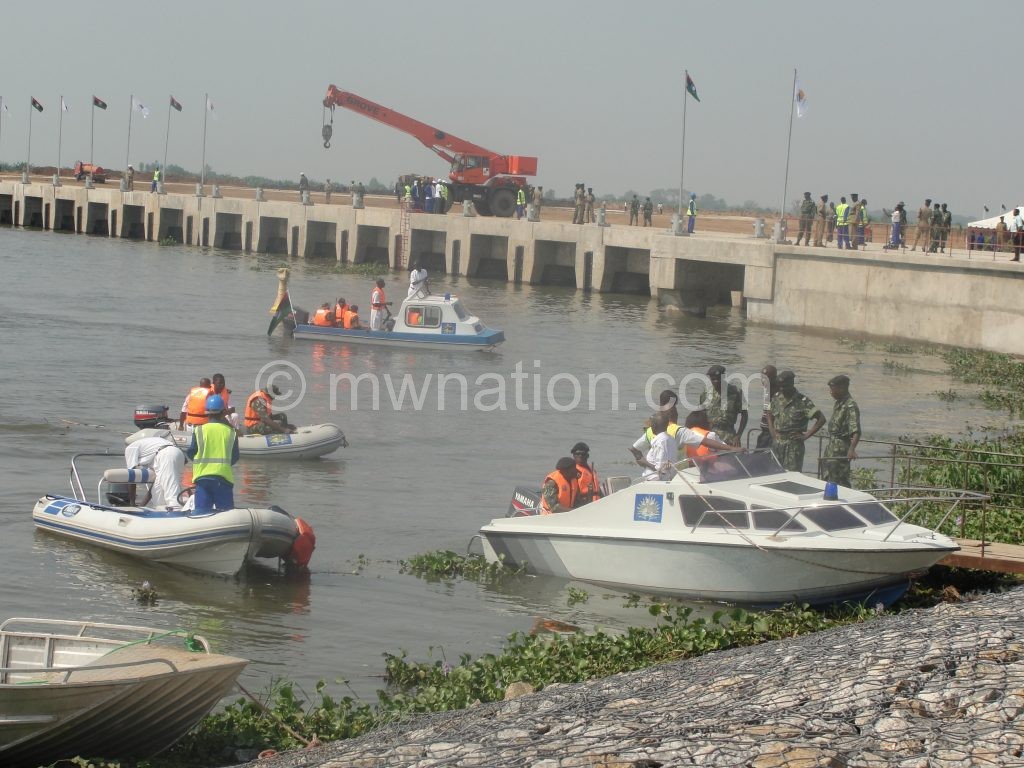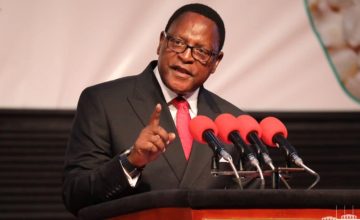Nsanje Inland Port dries up
The colour dream of former president the late Bingu wa Mutharika—the Nsanje Inland Port—is fast fading away as the port, which cost the country $20 million, is now hanging above a muddy swamp following the drying up of the Shire River on the port’s section.
Currently, the Shire River water levels at Nsanje Inland Port have decreased to lowest levels in decades, exposing the riverbed which is now characterised by cracked mud signifying the impact of intense heat in the Lower Shire.

The drying of the Shire River vindicates Mozambique government’s position on the issue which questioned the viability of the project by looking at the ever-decreasing water levels in both Shire and Zambezi rivers.
The drying of the port this year is a result of the dwindling of water inflows in the Shire River and Lake Malawi due to the El Nino weather episode in the 2015/16 rainy season which has also affected power generation in the country.
The Electricity Supply Corporation of Malawi (Escom) has warned that the country should brace for prolonged hours of black-outs following the continued dwindling of water flows in the Shire and Lake Malawi.
Escom announced in April this year that the flow of Shire River is still around 170 cubic metres per second (cumecs). Although the figure was an increase over the previous month, it was still far below the flow of about 264 cumecs required for optimum power generation.
The other major tributaries of the Shire River are Mwanza and Ruo Rivers but Escom public relations officer George Mituka said in April that due to the inconsistent rainfall pattern especially in the southern areas and downstream of Kamuzu Barrage at Liwonde, the tributaries are not making significant contribution to improving Shire River flows.
In 2015, Mozambique Minister of Transport Carlos Mesquita said the viability of the waterway project could only be assessed if the consultant determines the behaviour of water levels in the Shire and Zambezi rivers, the cost of maintenance of the waterway and the rights of the fishing families along the two rivers.
He casted doubt if Mozambique would adopt the feasibility study report conducted by Hydroplan GmbH, on the navigability of the rivers which has been a dominant feature from the neighbouring country’s side as evidenced by its sending of mixed signals on the matter.
Ministry of Transport and Public Works, which is the line ministry for the project, did not respond to a Weekend Nation questionnaire, but the government spokesperson, Minister of Information Patricia Kaliati insisted that the project was well on course despite the climatic challenges and the complications of a regional setup that it has taken.
Said Kaliati: “The project is on and that is the official position of the government of Malawi. It has been adopted by the Southern African Development Community (Sadc) as a regional project. These things take time but work is being done and you shall see it soon. Although the climate issues are there, the technicians had already taken all those issues into consideration.”
Sadc, through the African Development Bank (AfDB), in 2011 pumped in US$ 3.5 million (K2.5 billion) into the comprehensive feasibility study on the Shire-Zambezi Waterway project which was initially projected to cut Malawi’s transportation of goods costs to and from the Indian Ocean ports by 40 percent.
The project had also roped in Zambia and Zimbabwe to make it more regional based. The countries adopted the study that gave a green light to the navigability of the two rivers.
However, a senior lecturer in Environmental Sciences from the Physics and Biochemical Sciences department at the Polytechnic in Blantyre, Chikumbusko Kaonga said recent climatic factors have made the project unattainable.
“If we base our arguments on current water levels and climate change
issues, then the materialisation of the project is almost impossible. However, there is hope in that there is a project (Shire River Basin Management Project) which is trying to restore the Shire River basin to its former glory. On the other hand, government may be ready but the involvement of other countries such as Zambia and
Mozambique makes the whole thing very tricky,” he said.
Additionally, the expert said feasibility studies which look at the practicality of proposed plans or method within a specific period of time may contain a margin of error.
“Since these are plans or methods, they may contain some errors in them as such they are not 100 percent correct. But the drying of the Shire River this year can be attributed to the dry spells that have hit the region as a result of the El Nino phenomenon. However, that does not make the feasibility study entirely incorrect,” he said.
A team of ministers from the regional grouping considered the report by consultants on the navigability of the Shire-Zambezi Waterway whose proposed route is from Nsanje in Malawi to Chinde, the small Mozambican town at the mouth of the Zambezi River into the Indian Ocean, stretching over a distance of 343 kilometres through Mozambican territory.
In 2012, Mozambique refused to allow the use of Zambezi River for commercial shipping but changed tune later when its Foreign Minister and Cooperation Oldemiro Baloi said experts from the two countries would collaborate on the feasibility study and environmental impact assessment.
Sadc director of Infrastructure and Services Remmy Makumbe in 2013 said the grouping had committed itself to coordinating the study and said it would include Zambia and Zimbabwe to ensure smooth running of the project.
Although in 2014 president Mutharika after attending the 34th Sadc Summit at Victoria Falls in Zimbabwe said Sadc had endorsed the project, in April 2016 Mozambique president Felipe Nyusi questioned the viability of the project, saying it was just an ambition by Zambia and Malawi to cut transportation costs, urging the two countries to explore other means.






Still at a loss to understand how a poor country can spend $20m on a project without complete feasibility studies, environmental assessment and without full participation of the state downstream. Just imagine what you could actually have done useful with $20m. Bingu was a clever man, but cannot understand this at all! Can someone check the construction contracts please…
And the whole Malawi nation full of its intelligent people wonders how Bingu ended up with K61 Billion in savings in his offshore accounts within 6 years of his presidency while living on a monthly salary of only K1.5 Million………………search me.
I had a privilege of knowing Mr Bingu personally and I know some people talk about his career at the World Bank and etc…………….but the only thing I can tell you friends is that by the time he was offered a job at the Reserve bank of Malawi, he was on a point of bankruptcy if not bankrupt already.
He was leaving in area 47 at the time, and non of his buses was running, he was even failing to me my K15,000 for the engine spare parts he had taken on loan a few months back.